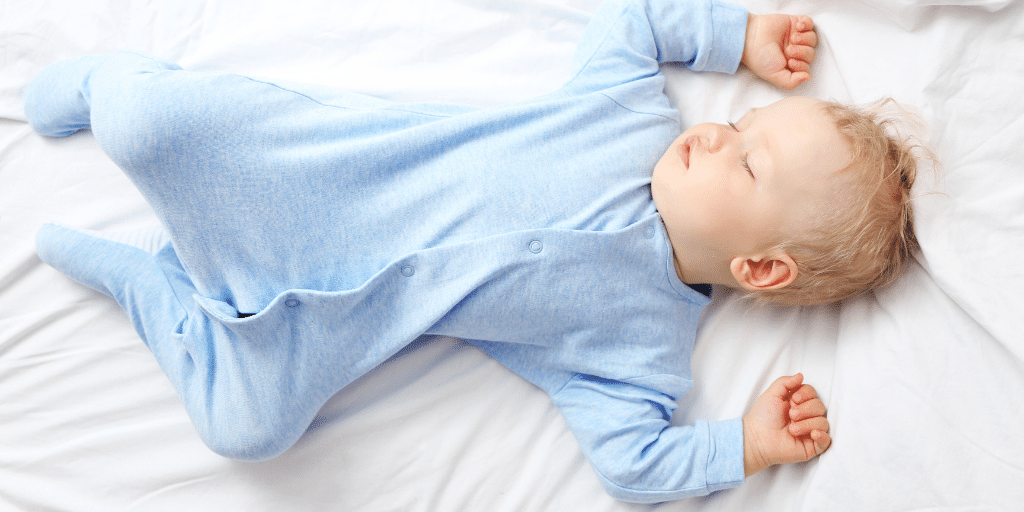This is a period when your baby is going through lots of physical changes – so how does that affect their sleep?
You might be thinking about;
- How much sleep should my little one be having?
- How to keep to a good sleep routine
- How much sleep should my bay have in the day, and in the night?
Before your baby gets to six months, their movement is limited and they have been spending quite a lot of their days and nights asleep. See our month-by-month nap guide to how much sleep your little one should be getting.
Now, however, they are starting to get a lot more mobile! If they’re not crawling yet, they are certainly on their way towards it. They may be sitting up well, bum-shuffling, cruising around the furniture, rocking on all fours, rolling over and pushing their head and arms up when you give them their Tummy Time. Toys are there to be built up and knocked down or batted at.
How does this affect their sleep? You’d think that all that extra activity would tire them out – and to some extent, it does and helps them make the transition towards sleeping more at night and less in the day.
However, if they have enjoyed all that extra activity, they may start to try it out when they are supposed to be sleeping! There’s an actual moment when your baby discovers “up” – that there are things above the to be looked at and reached for. Once they have discovered this there’s no turning back.
Of course, this means that they will try to crawl, stand and cruise in the cot and then it can be really hard to get them to sleep.
How Do I Get a Curious Baby to Nap and to Sleep?
Watch for your baby’s sleep cues – you should be used to most of them by now. They might rub their eyes, pull at the ears, yawn, be grumpier than before and lose interest in a game you’re playing or a toy they have been enjoying.
Remember that gap you have between baby being tired enough to settle easily and the point when they have become overtired. Try to ensure that you go through your sleep or nap routine when you recognise this, or if you’re out, put them in their stroller and pull down the hood and pop on your SnoozeShade to reduce stimulation – they need to be in a calm, quite environment.

What Should I Be Doing?
- Change your baby’s mattress height: If they have been sleeping in a cot or crib on its highest mattress setting, it’s time to move it down once they can pull themselves up. You may also need to move on from a Moses basket or crib into a larger cot or cot bed.
- Observe what they are doing in their cot: Make sure there are no toys, cushions or bumpers in the cot, as your baby may use them to climb on and could injure themselves. Cot bumpers can be dangerous and you should remove them to avoid the risk of getting caught in them or even strangulation.
- Put them into a sleeping bag rather than a swaddle or sheets and blankets: That way, they won’t feel restricted and they are unable to kick the bag off. If they were to kick off sheets and blankets, they would wake up cold and wake you too!
- Reduce daytime naps and increase nighttime sleep: See our helpful chart to see how long your baby should be sleeping in the day and at night.
- Don’t forget to have all you need to hand ready for naps and sleep, including any sleep prop your baby likes such as a muslin or white noise toy. You may need to help them to drop off by rocking or feeding them – then settle them down while sleepy but not yet asleep if you can. Read a calm, repetitive story that they know and love and hopefully, they should soon be in the land of nod.
How Much Sleep Do They Need?
Six to Nine Months - Your baby needs three hours of sleep during the day, 11 hours at night.
Nine to Twelve Months - At this age, your baby should still be having two good naps a day. They now need two and a half hours of sleep during the day, 11 hours at night.
Where to Nap?
Try to make sure that one nap is at home in their cot. It’s fine for the other to be when you’re out with the car or with the stroller. Don’t worry too much if you have days when they are going out to activities and baby classes and they sleep on the way back! If your little one is at Nursery, make sure you speak to the staff about when they are put down for a nap and try to ask for their routine to mimic yours. Take their sleep props and comforters in with them, such as their sleeping bag and a comforter.
The Great Shift
When your baby approaches their first year, they have another developmental leap – they will want to start walking. All babies are different, so don’t worry if your baby gets to this stage earlier or later than their little pals. At this stage they may once again struggle to sleep, as they will want to move about in their cots which offers the perfect supports for those wobbly little steps.
You may wish to leave them to have a little play like this between their bath and starting the last part of their bedtime routine. Try to help them lie down by themselves rather than always putting them down – otherwise they will always want you to do this! This phase will pass as soon as the novelty wears off.
Further Reading:
Understanding How Your Baby Sleeps (Newborn to 3 Months)
Understanding How Your Baby Sleeps (12-18 Months)
Understanding How Your Baby Sleeps (18 Months+)




